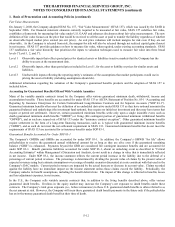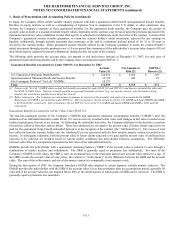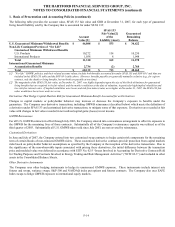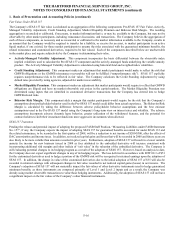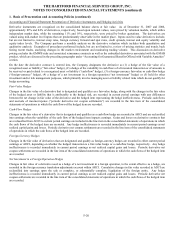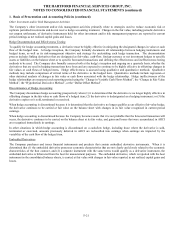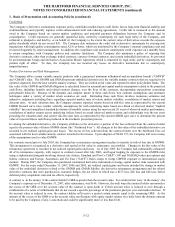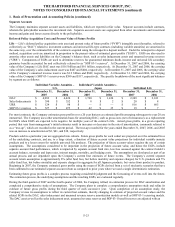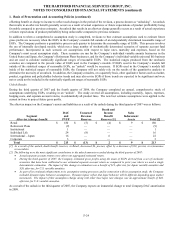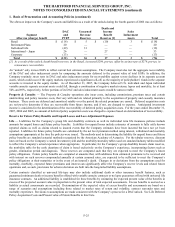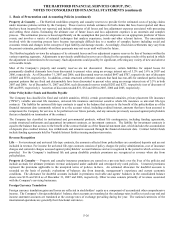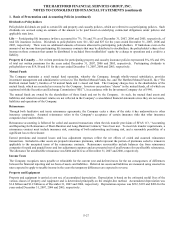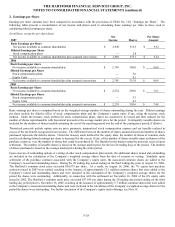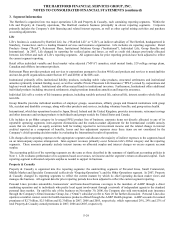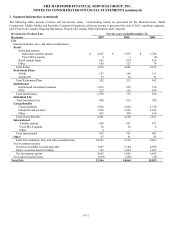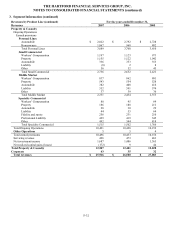The Hartford 2007 Annual Report Download - page 199
Download and view the complete annual report
Please find page 199 of the 2007 The Hartford annual report below. You can navigate through the pages in the report by either clicking on the pages listed below, or by using the keyword search tool below to find specific information within the annual report.
THE HARTFORD FINANCIAL SERVICES GROUP, INC.
NOTES TO CONSOLIDATED FINANCIAL STATEMENTS (continued)
F-22
1. Basis of Presentation and Accounting Policies (continued)
Credit Risk
The Company’ s derivative counterparty exposure policy establishes market-based credit limits, favors long-term financial stability and
creditworthiness and typically requires credit enhancement/credit risk reducing agreements. Credit risk is measured as the amount
owed to the Company based on current market conditions and potential payment obligations between the Company and its
counterparties. Credit exposures are generally quantified daily, netted by counterparty for each legal entity of the Company, and
collateral is pledged to and held by, or on behalf of, the Company to the extent the current value of derivatives exceeds the exposure
policy thresholds which do not exceed $10. The Company also minimizes the credit risk in derivative instruments by entering into
transactions with high quality counterparties rated A2/A or better, which are monitored by the Company’ s internal compliance unit and
reviewed frequently by senior management. In addition, the compliance unit monitors counterparty credit exposure on a monthly basis
to ensure compliance with Company policies and statutory limitations. The Company also maintains a policy of requiring that
derivative contracts, other than exchange traded contracts, currency forward contracts, and certain embedded derivatives, be governed
by an International Swaps and Derivatives Association Master Agreement which is structured by legal entity and by counterparty and
permits right of offset. To date, the Company has not incurred any losses on derivative instruments due to counterparty
nonperformance.
Product Derivatives and Risk Management
The Company offers certain variable annuity products with a guaranteed minimum withdrawal and accumulation benefit (“GMWB”
and “GMAB”) rider. The GMWB and GMAB represent embedded derivatives in the variable annuity contracts that are required to be
reported separately from the host variable annuity contract. They are carried at fair value and reported in other policyholder funds. The
fair value of the GMWB and GMAB obligation is calculated based on actuarial and capital market assumptions related to the projected
cash flows, including benefits and related contract charges, over the lives of the contracts, incorporating expectations concerning
policyholder behavior. Because of the dynamic and complex nature of these cash flows, best estimate assumptions and stochastic
techniques under a variety of market return scenarios are used. Estimating these cash flows involves numerous estimates and
subjective judgments including those regarding expected market rates of return, market volatility, correlations of market returns and
discount rates. At each valuation date, the Company assumes expected returns based on risk-free rates as represented by the current
LIBOR forward curve rates; market volatility assumptions for each underlying index based on a blend of observed market “implied
volatility” data and annualized standard deviations of monthly returns using the most recent 20 years of observed market performance;
correlations of market returns across underlying indices based on actual observed market returns and relationships over the ten years
preceding the valuation date; and current risk-free spot rates as represented by the current LIBOR spot curve to determine the present
value of expected future cash flows produced in the stochastic projection process.
In valuing the embedded derivative, the Company attributes to the derivative a portion of the fees collected from the contract holder
equal to the present value of future GMWB claims (the “Attributed Fees”). All changes in the fair value of the embedded derivative are
recorded in net realized capital gains and losses. The excess of fees collected from the contract holder over the Attributed Fees are
associated with the host variable annuity contract recorded in fee income. Upon adoption of SFAS 157, the Company will revise many
of the assumptions used to value GMWB.
For contracts issued prior to July 2003, the Company has a reinsurance arrangement in place to transfer its risk of loss due to GMWB.
This arrangement is recognized as a derivative and carried at fair value in reinsurance recoverables. Changes in the fair value of the
reinsurance agreement is recorded in net realized capital gains and losses. As of July 2003, the Company had substantially exhausted
all of its reinsurance capacity, with respect to contracts issued after July 2003, and began hedging its exposure to the GMWB rider
using a sophisticated program involving interest rate futures, Standard and Poor’ s (“S&P”) 500 and NASDAQ index put options and
futures contracts and Europe, Australasia and Far East (“EAFE”) Index swaps to hedge GMWB exposure to international equity
markets. During 2007, the Company also purchased customized derivative instruments to hedge capital market risks associated with
GMWB. For the years ended December 31, 2007, 2006 and 2005, net realized capital gains and losses included the change in market
value of the embedded derivative related to the GMWB and GMAB liability, the derivative reinsurance arrangement and the related
derivative contracts that were purchased as economic hedges, the net effect of which was a $277 loss, $26 loss and $46 loss, before
deferred policy acquisition costs and tax effects, respectively.
A contract is ‘in the money’ if the contract holder’s GRB is greater than the account value. For contracts that were ‘in the money’ , the
Company’ s exposure as of December 31, 2007, after reinsurance, was $146. However, the only ways the contract holder can monetize
the excess of the GRB over the account value of the contract is upon death or if their account value is reduced to zero through a
combination of a series of withdrawals that do not exceed a specific percentage of the premiums paid per year and market declines. If
the account value is reduced to zero, the contract holder will receive a period certain annuity equal to the remaining GRB. As the
amount of the excess of the GRB over the account value can fluctuate with equity market returns on a daily basis the ultimate amount
to be paid by the Company, if any, is uncertain and could be significantly more or less than $146.


